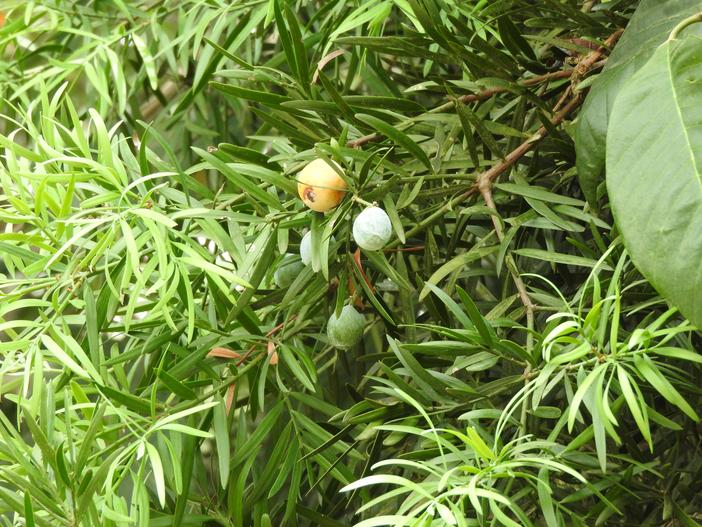Nageia
(Nageia wallichiana)
Nageia (Nageia wallichiana)
/
/

Yercaud-elango
CC BY-SA 4.0
Image By:
Yercaud-elango
Recorded By:
Copyright:
CC BY-SA 4.0
Copyright Notice:
Photo by: Yercaud-elango | License Type: CC BY-SA 4.0 | License URL: https://creativecommons.org/licenses/by-sa/4.0 | Uploader: Yercaud-elango | Publisher: Wikipedia Commons












Estimated Native Range
Summary
Nageia wallichiana, commonly known as Nageia, is an evergreen coniferous tree native to the subtropical and tropical forests of South and Southeast Asia, particularly in areas with high humidity such as the lower montane forests. It can grow up to 50 meters tall with a straight, cylindrical stem and a crown that is typically conical in young trees, becoming more rounded with age. The bark of Nageia wallichiana is smooth with a distinctive brown and white mottled appearance and is about 0.5 inches thick. The leaves are flat, broad, and leathery, with a glossy green color. This species does not produce showy flowers; instead, it bears inconspicuous male and female cones on separate trees, with the female cones developing into fleshy, berry-like seeds.
Nageia wallichiana is valued for its timber and is also used in traditional medicine. In cultivation, it is often planted for reforestation projects and as an ornamental tree in large gardens and parks due to its impressive height and evergreen foliage. It requires full sun to partial shade and can adapt to a range of soil types, provided they offer good drainage. While it tolerates medium amounts of water, it thrives in moist conditions that mimic its native habitat. Gardeners should be aware that due to its potential size and root system, it is not suitable for small spaces.CC BY-SA 4.0
Nageia wallichiana is valued for its timber and is also used in traditional medicine. In cultivation, it is often planted for reforestation projects and as an ornamental tree in large gardens and parks due to its impressive height and evergreen foliage. It requires full sun to partial shade and can adapt to a range of soil types, provided they offer good drainage. While it tolerates medium amounts of water, it thrives in moist conditions that mimic its native habitat. Gardeners should be aware that due to its potential size and root system, it is not suitable for small spaces.CC BY-SA 4.0
Plant Description
- Plant Type: Tree
- Height: 30-150 feet
- Width: 20-50 feet
- Growth Rate: Moderate
- Flower Color: N/A
- Flowering Season: Non-Flowering
- Leaf Retention: Evergreen
Growth Requirements
- Sun: Full Sun
- Water: Medium
- Drainage: Slow, Medium, Fast
Common Uses
Low Maintenance
Natural Habitat
Native to subtropical and tropical forests of South and Southeast Asia, particularly in lower montane forests with high humidity
Other Names
Common Names: Brown Podocarp, Brown’s-Pine, Mala Almaciga, Brown’s Pine, Bali, Damar Laki Laki, Kayu Bulu Soma, Kayu Cina, Kebal Musang, Mengilan
Scientific Names: , Nageia wallichiana, Podocarpus blumei, Decussocarpus wallichianus, Podocarpus wallichianus, Nageia blumei, Podocarpus agathifolius,
GBIF Accepted Name: Nageia wallichiana (Presl) Kuntze